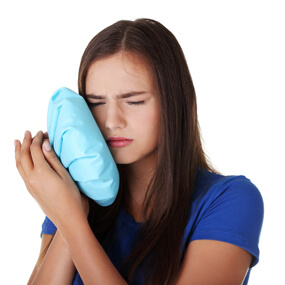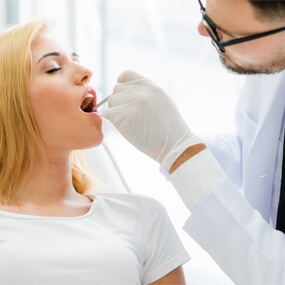Dental Plaque: The Causes and How to Eliminate It

Nothing presents more risk to your oral health than dental plaque. Plaque is the cause of gum disease and the leading cause of tooth decay. Plaque accumulates on your teeth practically all the time and can cause halitosis and yellow your teeth in the lead-up to more serious health issues. The best way to reduce plaque buildup is to brush your teeth, floss, and scrape your tongue twice a day.
Dental Plaque: What It Is
Dental plaque is a community of bacteria that form a biofilm on the teeth, along the gumline, and on other oral surfaces. In plainer language, plaque is a sticky and yellowish substance that forms on your teeth as saliva, food particles, and bacteria mix. Plaque is forming almost constantly due to the foods you eat and beverages you drink. Brushing and flossing are necessary to clean and disturb that growth.
Plaque that is left to accumulate is a big problem because it contains bacteria and acids. The acids wear at your tooth enamel and lead to tooth decay, and the bacteria causes infections that lead to gum disease. In addition, plaque eventually calcifies into dental calculus—commonly called tartar—which worsens the situation by providing even more surface area on which plaque can accumulate and spread. Even more troublesome is that tartar cannot be cleaned through brushing and flossing alone.
Dental Plaque: How It Forms
Dental plaque occurs due to a chemical reaction in the mouth and begins to form as soon as you chew food or drink a beverage. Bacteria uses food particles—carbohydrates in particular—as nutrition to grow. Acids are a byproduct of this process. These acids mix with other food particles and your saliva to create plaque. Carbohydrates are found in many foods, including those that are quite healthy, but foods heavy in simple carbohydrates, such as candies and potato chips, are the most problematic.
Dental Plaque: How to Avoid It
While it may not be possible to avoid plaque completely, you can limit its presence considerably. Balance your diet. Avoid simple carbohydrates. Limit your unhealthy snacking, and stay hydrated. When it comes to carbs, opt for complex carbs like wheat pasta and bread rather than simple carbs like white pasta and bread. Take these steps, and you will limit plaque as much as possible.
The next step is to brush your teeth, floss, and scrape your tongue twice a day. These practices not only clean plaque but disturb it so that it cannot harden into tartar. When you brush your teeth, do so with a soft-bristled brush and for two to three minutes. Be sure to brush each side of each tooth. Floss and scrape whenever you brush, and you can floss more often if you like. Always wait 30 minutes before brushing after a meal to give acids time to dissipate. You can rinse vigorously with water directly after meals, and sugar-free gum with xylitol is a good option to promote saliva and help to inhibit plaque formation.
Dental Calculus
Plaque on a surface begins hardening into tartar right way. The process takes 48 hours on average, but it can happen in as quickly as 24 hours, which is why the American Dental Association emphasizes flossing once a day at a bare minimum. Once calcification is complete, it is practically impossible for you to remove using the basic oral care tools that you have at home. You will have to go to an oral hygienist who will professionally scrape the tartar off your teeth. Note that while some toothpastes are marketed as tartar control, this actually refers to cleaning plaque before it can become tartar.
Dental Plaque: Facts and Stats
- A CDC report indicates that 47.2 percent of adults age 30 and up have periodontal disease.
- Plaque accumulation leads to periodontal disease, tooth decay, and tooth loss.
- Plaque on a tooth or other surface starts calcifying into dental calculus right away.
- Red wine and green tea help to inhibit plaque growth, but red wine can stain your teeth!
- Green tea drinkers are 20 percent less likely to lose teeth due to plaque accumulation.
- Eating natural cranberries and drinking sugar-free cranberry juice can reduce plaque by 50 percent.
- Olive oil and other foods can create a natural barrier on the teeth that stops plaque formation.
- Due to increased hormones, pregnant women are more susceptible to plaque buildup.
- Gum disease is often silent in that it does not manifest even the most common symptoms.
The Realities of Dental Plaque
Thinking about dental plaque can be an unpleasant exercise, but plaque is a fact of life, and ignoring it can lead to a wide range of serious oral health issues and, in turn, general health issues. Maintaining a plaque-free mouth does not have to be a hassle, however. If you establish good oral hygiene, managing plaque requires less than 10 minutes a day. However, when oral hygiene is not properly maintained, and plaque becomes a problem, getting back on track can be problematic in that it requires a deep scaling treatment to remove calcified deposits.
Keep Your Teeth and Gums Plaque-Free
Reducing dental plaque in your mouth begins at home with regular brushing and flossing. You should also visit Scottsdale Cosmetic Dentistry Excellence for regular cleanings and checkups. An oral hygienist can remove any plaque and tartar you missed, and Jeffrey D. Clark, DDS, can ensure that there are no indications of gum disease, tooth decay, and other health issues. Call our office today at 480 585 1853 to schedule your next cleaning and checkup.




